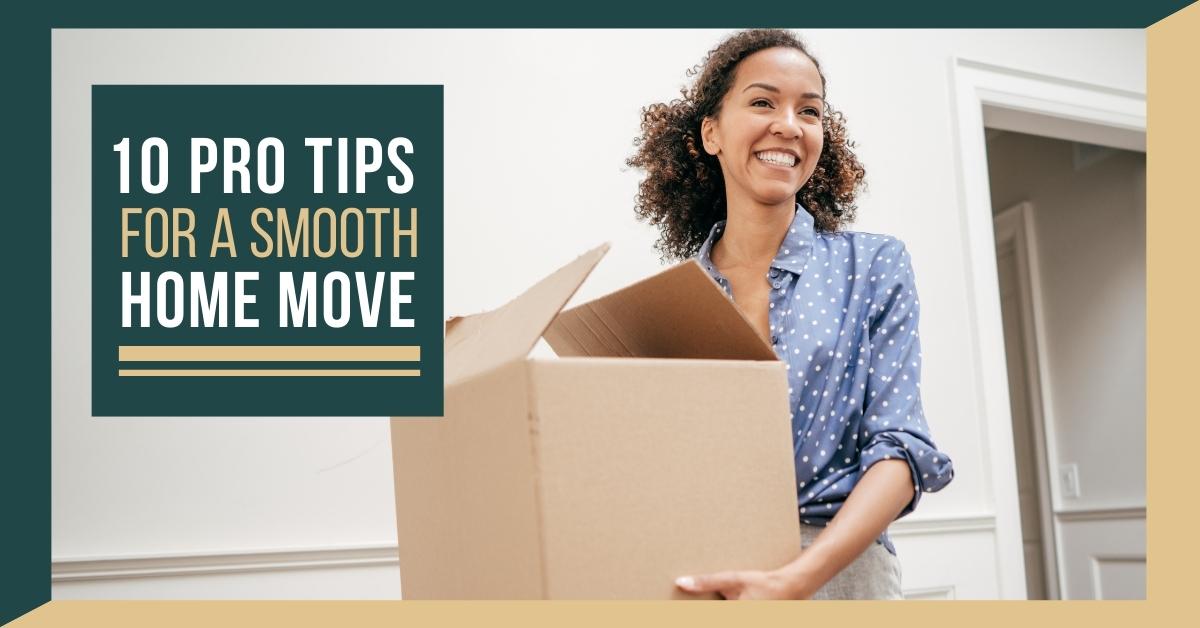
The process of buying a new home can be both exhilarating and exhausting. But the journey doesn’t stop when you close on your property. On the contrary, you still have quite a bit to do before you can begin the process of settling into your new place.
Fortunately, you don’t have to do everything in a day. You don’t have to do it all alone, either. When you work with us to sell or purchase a home, you’ll have an ally by your side long after your transaction has closed. We’ll continue to be a resource, offering advice and referrals whenever you need them on packing, hiring movers and contractors, and acclimating to your new home and neighborhood.
When it comes to a life event as stressful as moving, it pays to have a professional by your side. Here are some of our favorite pro tips to share with clients as they prepare for an upcoming move.
1. Watch out for moving scams.
Maybe you receive a flyer for a moving company in the mail. Perhaps you find a mover online. Either way, never assume that you’re getting accurate information. According to the Better Business Bureau, moving-related fraud is on the rise. In 2021 alone, individuals and families reported more than $730,000 lost to moving scams, an increase of 216% over the previous year.1
How can you tell if a moving deal is too good to be true? Trust your instincts. If the price appears too low or you can’t pin down the mover’s physical business address, try someone else. The same goes for any moving company representative who dodges questions. Reputable movers should offer transparent pricing, conduct in-home estimates, and provide referrals and copies of their insurance documents upon request.2 For help finding trustworthy movers, reach out. We’d be happy to share our recommendations.
2. Insure your belongings.
Your moving company promises to take care of your custom piano or your antique furniture. But don’t just take their word for it. Ask to see how much insurance they carry and talk about how the claims process works. That way, you’ll know what is (and isn’t) covered in case of loss or damage.
Of course, some items are priceless because they’re irreplaceable. You might want to move your more sensitive valuables (jewelry, documents, family heirlooms, etc.) in your own vehicle just to be safe. For added peace of mind, call your rental or home insurance provider if you’re moving anything yourself. You might already be protected or be able to purchase extra insurance to cover your move. If those options are unavailable, you could opt for moving insurance from a third-party carrier.3
3. Start packing when you start looking for a new home.
As soon as your house hunting begins in earnest, think about packing away things you won’t need for the next few months. These could include seasonal or holiday decor, clothing, and books. Tackling just one or two boxes a day will give you a head start.
If you're going to put your current home on the market, you'll want to declutter anyway. Decluttering will make your home seem larger, and depersonalizing helps buyers envision their own items in the space. Consider selling, donating, or throwing out possessions you no longer need. The things you want to keep can be placed in storage until you officially start moving to a new place.
4. Pack to make unpacking easier.
Have you ever opened a packed box only to find that it’s filled with an assortment of items that don’t belong together? This isn’t efficient and will only make unpacking harder. A better way to pack is to bundle items from a single room in a labeled box. Labels can let movers know (and remind you) where to place each box, whether it’s fragile, and which side needs to be up. Some people like to assign colors to each room in their new home to make distributing color-coded boxes a breeze.
Feel free to unleash your inner organizer with this project. For example, you could create a spreadsheet and assign each box a number. As boxes are packed, simply fill in the spreadsheet with a list of contents. Anyone with access to the spreadsheet can log in and quickly find the desired item.
5. Think outside the box when transporting clothes.
Who wants to worry about boxing up clothes? If you plan on hiring professional movers, ask if you can leave clothing in your dressers. In many cases, they will use plastic to wrap the dresser so the drawers don’t fall out during transport. If keeping your clothes in your furniture makes it too heavy, the movers might be able to wrap and move drawers by themselves.
Another easy transport trick involves turning clean garbage bags into garment bags. Poke a hole in the bottom of a garbage bag, turn the bag upside down, slide it over five to seven garments on hangers, and lay the items flat in the back seat or trunk of your vehicle. The bags will help prevent wrinkling, and your clothes will be ready to hang up when you get to your new home.
6. Document prior to disassembling appliances and furnishings.
Few things are as confusing as looking at a plastic baggie filled with nuts, bolts, and screws from your disassembled dining room table or sorting through a box of electrical wires and cords to see which ones fit your TV.
The best workaround to easier reassembly is to document the disassembly process. Take photos and videos or thorough notes as you go. Whether it’s your headboard or treadmill, be very precise. And just a tip: Construct your beds first when you get to your new home. After a long moving day, the very last thing you want is to be assembling beds into the wee hours of the morning.
7. Prioritize unpacking kids’ rooms.
Children can become very stressed by a big move. To ease their transition, consider prioritizing unpacking their rooms as their “safe zones.”4 You aren’t obligated to unpack everything, certainly. However, set up your children’s rooms to be functional. That way, your kids can hang out in a private oasis away from the chaos while you’re running around and moving everything else.
Depending upon how old your youngsters are, you might want to give them decorating leeway, too. Even if it’s just letting them choose where furniture goes, it gives them a sense of buy-in. This can help ease the blues of leaving a former home they loved.
8. Be a thoughtful pet parent.
Many types of pets can’t handle the commotion of moving day. Knowing this, be considerate and seek ways to give your pets breaks from the action. You might ask a friend to pet sit your pooch or keep your kitty in a quieter room, like a guest bathroom.
Be sure to check in on your pet frequently. Pets like to know that you’re around. Give them treats, food, and water throughout the day. When it’s time to transport your pet, do it calmly. At your new property, give your pet access to just a room or two at first. Pets typically prefer to acclimate themselves slowly to unfamiliar environments.5
9. Plan for your move like you’re planning for an exciting vacation.
When you plan vacations, you probably look up local restaurants, shops, and recreational areas. Who says you can’t do the same thing when moving? Create a list of all the places you want to go and things you want to do around your newly purchased home. Having a to-explore list keeps everyone’s spirits high and gives you starting points to settle into the neighborhood.
And don’t feel that you have to cook that first night. Once the moving trucks are gone, you can always pop over to a local eatery or order DoorDash for major convenience. The first meal in your new home should be a happy, welcoming treat. And if you’re relocating to our neck of the woods, we would love to introduce you to all the hot spots in town and recommend our local favorites.
10. Pack an “Open Me First!” box.
You won’t be able to unpack all your boxes in one day, but you shouldn’t go without your sheets, pillows, or toothbrush. Designate some boxes with “Open Me First!” labels. (Pro tip: Keep a tool kit front and center for all that reassembling.)
Along these lines, use luggage and duffel bags to transport everyone’s personal must-have items and enough clothing for a couple of days. That way, you won’t have to rummage through everything in the middle of your move looking for sneakers or snacks.
When packing your “Open Me First!” boxes, think about which items you’ll need in those first 24 hours. For example, toilet paper and hand soap are musts. A box cutter will make unpacking a lot easier, and paper towels and trash bags are sure to come in handy. Reach out for a complete, printable list of “Open Me First!” box essentials to keep on hand for your next move!
LET’S GET MOVING
Getting the phone call from your real estate agent that your bid was accepted is a thrilling moment. Make sure you keep the positivity flowing during the following weeks by mapping out a streamlined, efficient move. Feel free to get in touch with us today to help make your big move your best move.
Sources:
- Better Business Bureau -
https://www.bbb.org/article/scams/24198-bbb-scam-alert-avoid-moving-scams-this-national-moving-mont - Move.org -
https://www.move.org/how-to-tell-moving-company-scam/ - Forbes -
https://www.forbes.com/advisor/homeowners-insurance/moving-insurance/ - New York Times -
https://www.nytimes.com/2020/07/13/parenting/moving-tips-kids.html - ASPCA -
https://www.aspca.org/pet-care/general-pet-care/moving-your-pet
About the Author

Jennifer Sample
I Live Here - I Work Here- I Love It Here! With 30 years’ experience buying and selling homes in San Antonio, Jennifer knows this market well and is ready to share her knowledge and expertise to serve you – whether you’re buying your first home, downsizing and selling your family home, or investing. As a Certified Pricing Strategy Advisor she can help you Sell or Buy you home at the right price.